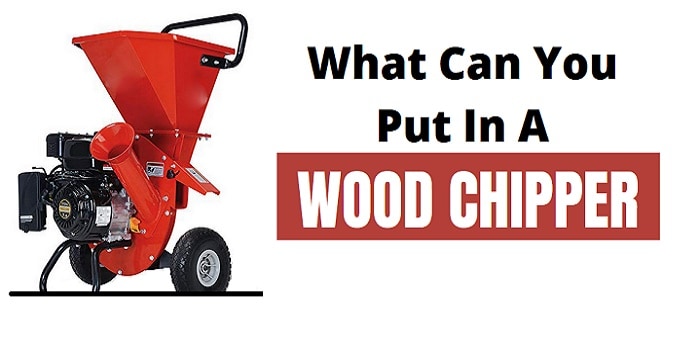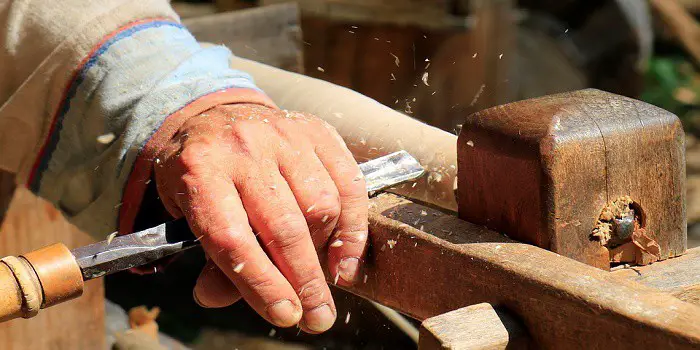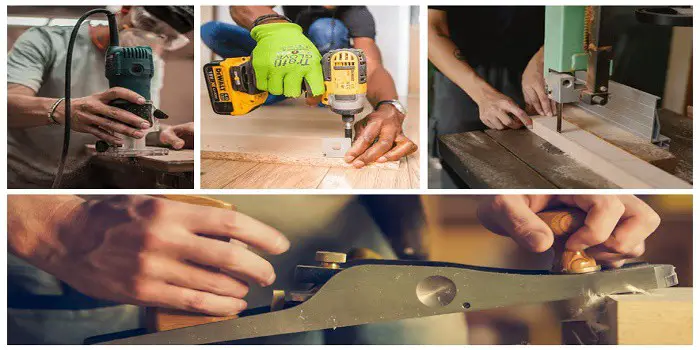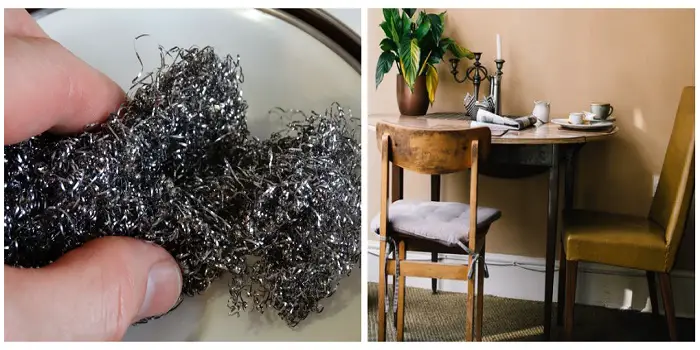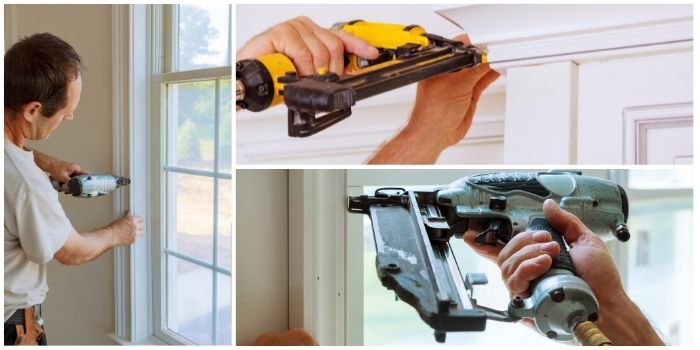
You’ve just bought a new house, and you’re in the process of fixing it up. You’ve been going through some old boxes in the attic, and you find a bunch of nails.
You’re not sure what they’re for, but you know you need a nail gun to use them. But which kind? A framing nailer or a Brad nailer?
In this article, we’ll compare framing nailers and brad nailers, so you can decide which one is right for your project.
Also, I will discuss what’s the difference between the two and which one is better for your project. Read on to find out the answers to these questions.
Framing Nailer
Framing nailers are also known as stick nailers because they use long strips of nails called sticks. The nails in a stick are usually held together by wire or plastic.
To load a framing nailer, you insert the strip of nails into the nail gun. Then, you pull the trigger to fire the nails.
Framing nail guns are available in both cordless and pneumatic versions. They are mostly used for construction work, mainly to connect pieces of wood together, such as in framing a house.
Pneumatic framing nailers are powered by compressed air, while cordless framing nailers are battery-operated.
There are also gas-type framing nail guns available that use gas as fuel to operate. If you choose a gas framing nail gun, make sure you bring enough gas cartridges with you to complete the task.
Brad Nail Guns and Finish Nailers
Brad nail guns (also called a tacker or a stapler) are similar to framing nailers, but they use shorter nails.
To load a Brad nailer, insert the strip of shorter nails into the nail gun and pull the trigger to fire the nails.
Like the framing nailers, Brad nail guns are also available in both cordless and pneumatic versions. But they are mostly used for finishing work, such as to connect pieces of wood together in trim work or cabinets.
There are also finish nailers that are similar to Brad nailers, but they use even shorter nails. This means they are designed for smaller detail jobs such as fastening, molding, fixing furniture, or any other job that requires small and detailed nails.
Framing Nailers and Brad Nailers Differences
The main difference between framing nailers and Brad nailers is the size of the nails they use – the former use long nails, while the latter uses shorter nails.
Another difference is that framing nailers are mostly used for construction work, while brad nailers are mostly used for finishing work.
The type of wood you are working on also makes a difference.
Framing nailers are designed for use with tougher woods, such as oak and maple. And because they’re larger and heavier than Brad nailers, they’re not as easy to use in tight spaces.
Brad nailers, on the other hand, are designed for use with softer woods, such as pine and cedar. And because they’re smaller and lighter than framing nailers, they’re ideal for use in tight spaces.
So, which type of nail gun should you use? The answer depends on the type of wood you’re working with and the size of the project.
If you’re working with tougher woods and need a heavier-duty nail gun, then a framing nailer is the way to go. But if you’re working with softer woods and need a lighter-duty nail gun, a Brad nailer is the best choice.
Also, if you’re working on a construction project, such as framing a house, then you should use a framing nailer. But if you’re working on a finishing project, such as trim work or cabinets, you should use a Brad nailer.
Either way, be sure to read the instructions carefully and always wear safety glasses when using a nail gun.
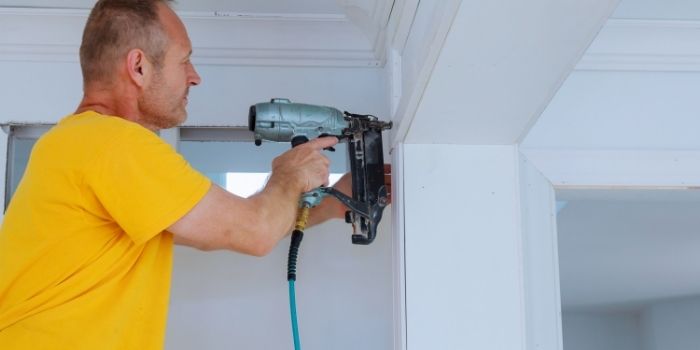
What to Look for in The Nailers When Buying Them?
When you go to the market or buy a nailer online, there are certain things you need to look for to make sure you’re getting a good quality product.
First of all, you need to decide whether you want a cordless or pneumatic nailer. If you choose a cordless nailer, make sure the battery is included.
Then you will need to check the following features:
1- Gauge
This is the thickness of the nails, and it’s the most important feature to look for when buying a nailer.
It’s roughly equivalent to the diameter of a nail in inches. And the greatest nail thickness that may be used with any given finish nailing device is defined by this variable.
The most common gauges are 16 and 18. However, there are below and above these gauges as well. If you’re not sure which one to choose, go for the 16-gauge nailer.
2- Length of Nails
Besides the gauge, you also need to consider the length of the nails. Nails come in different lengths, from 1 inch to 4 inches.
The most common lengths are 2 inches and 3 inches. And the length of the nails will depend on the project you’re working on.
For example, if you’re working on a trim project, you will need shorter nails. So, make sure the nailer you choose can accommodate the length of nails you need.
3- Trigger Type
There are two types of triggers – sequential and contact. Sequential triggers require you to pull the trigger each time you want to fire a nail.
Contact triggers allow you to keep the trigger pulled and fire nails as long as you keep the gun pressed against the surface.
So, which one should you choose? It depends on your preference. If you want more control over the nails, go for a sequential trigger.
4- Weight
This is important if you will be using the nailer for extended periods of time. A heavier nailer will be more difficult to use for long periods of time.
So, make sure the nailer you choose is not too heavy.
5- Capacity
This is the number of nails the gun can hold at one time. The higher the capacity, the fewer times you will need to reload the gun.
Making a choice according to this feature will depend on the project you’re working on.
For example, if you’re working on a large project, then you will need a nailer with a higher capacity.
6- Angled Nailer
Unlike straight nailers, this type of nailer is designed for use in tight spaces and is available in a wide range of angles to pick from.
The angle usually refers to the angle made by the specific finish nailer and your work surface.
Finishing nailers are frequently available in 20 and 22-degree angles. As a result, finding the finest finish nailer for your needs will be a breeze.
7- Safety Features
Look for a nailer with safety features, such as a safety switch or a depth-adjustment feature. These features will help prevent accidents.
Above all, check the warranty. Most nailers come with a one-year warranty. However, some manufacturers offer a longer warranty.
Also, it’s good to read the reviews before buying a nailer. This will help you see what other people are saying about the product.
FAQs
What size nailer do I need for baseboards?
For baseboards as well as crown molding, you will need a finish nailer. And the most common size for baseboards is the 16-gauge finish nailer.
However, there are other sizes as well, such as the 18-gauge finish nailer. But the 16-gauge is the most common and will work for most projects.
Also, keep in mind that baseboards are typically nailed in place using 1-1/4 inch nails, although 1-inch or 1-1/2 inch nails can also be used.
So, you need to be sure to use the appropriate size nail for the thickness of your baseboard material.
What kind of nail gun is best to use for paneling?
For paneling projects, you’ll need a Brad nailer. It’s also known as a tacker or a stapler.
While a finish nailer can finish the job, because a brad nailer is lighter and smaller than a finish nailer, it’s ideal for paneling tasks.
Keep in mind that 18 gauge nails are strongly advised when installing paneling. For panel installation, a Brad nailer drives nails between ⅝ and 2 inches long, which is perfect.
What type of nailer should I use on MDF and plywood?
MDF, which is medium-density fiberboard, is a type of composite wood that is made from wood fibers. It’s often used for cabinets, shelving, and other indoor projects.
Plywood is a type of wood made from multiple layers of thin wood veneers. It’s often used for building projects, such as walls, floors, and roofs.
For both MDF and plywood, you’ll need a finish nailer. Unlike Brad nailer, a finish nailer is designed for use with woods that are soft or close to the same hardness, such as MDF.
And because a finish nailer doesn’t split the wood, it’s ideal for use with plywood.
Also, remember that when working with MDF or plywood, you should use 1-1/4 inch to 2-inch finish nails.
Share the post "Framing vs. Brad Nailer – What Type of Nail Gun to Use?"

Hi, I am Mark Garner a professional carpenter, woodworker, and DIY painter. I live in the small city of Peoria, Arizona as a semi-retired woodworker. I have started this blog with a simple motive to help you with my wood experience in this sector. If you like to know more about what I love doing and how it all got started, you can check more about me here.

